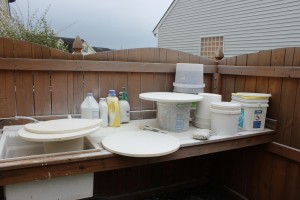Part of studio maintenance includes cleaning kiln shelves. This is a messy job and not one of my favorites. I use an angle grinder with a masonry blade to remove all the kiln wash which kicks up a ton of dust. I wear a face mask, ear plugs, and protective eye-ware; I also wear a bandanna around my hair to keep the dust out. It is quite the ordeal so I when I do scape shelves, I do all of them.
Here’s my process:
- Get dressed in shelf scraping outfit
- Gather all the shelves
- Use angle grinder to remove all kiln wash and glaze
- If glaze has bled into the shelf, I grind it until it is completely gone
- Once the shelves are bare of kiln wash, I wipe them down with a large, moist sponge
- I allow the shelve to dry before applying a thin layer of kiln wash
- I apply a layer kiln wash and allow it to dry approximately 10 minutes
- I apply 2-3 layers of kiln wash
- I allow the shelves to dry completely (at least a day) before using them in a bisque fire
I have been using Jeff Campana’s kiln wash recipe. The first few times, the kiln was was very thick and cracked quickly. This time, I thinned the kiln wash and sieved it before applying it to the shelves. So far, no cracks have appeared!



Hi!
I m trying Jeff’s kiln wash, I think mine is too thick 🙁
Did you just add extra water?
or/and extra Darvan 7??
Also do you think I shoild wipe them down again and start w a new application ? 🙁
Thank you,
Nadia
Thank you for asking. I had a similar problem. The kiln wash was too thick but I used it any way. It cracked and flaked off. So I added a lot of water and re-ground the shelves. Applying the watered-down kiln was much easier and quicker – and, it dried beautifully. Don’t give up on the recipe. I have been using it since my posting and I have found that the wash lasts a really long time and is very durable. Good luck and let me know how it works out for you.
Rae